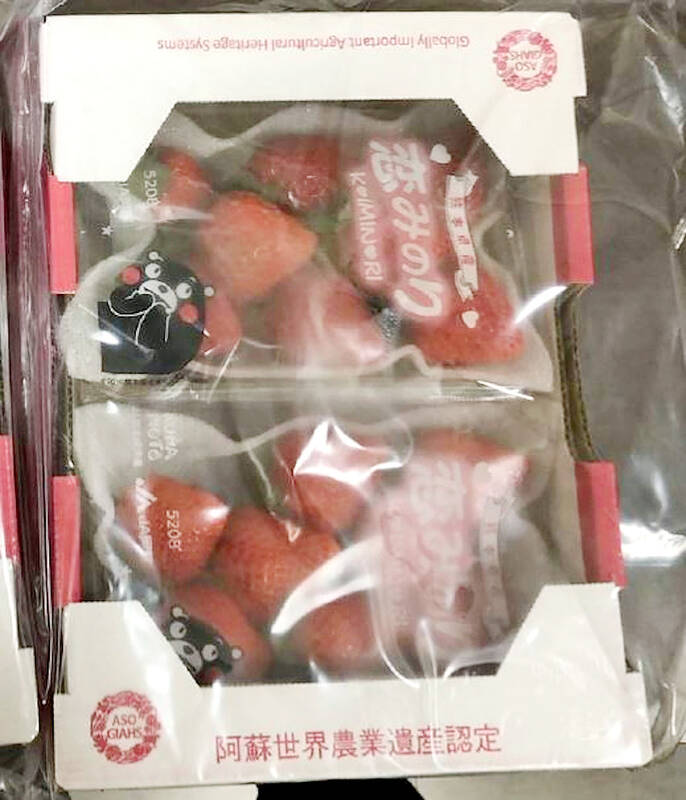Nearly 10 percent of 877 fruits, vegetables and agricultural products selected for pesticide residue tests in March and April were non-compliant, the Food and Drug Administration (FDA) said yesterday.
The 82 non-compliant products, or 9.4 percent of the total, included strawberries imported from Japan and roses imported from Iran, according to the FDA.
The tests, part of the FDA’s pesticide residue monitoring program, covered 611 samples specifically chosen for enhanced monitoring, of which 79 samples failed to meet regulatory standards, and 266 randomly selected samples, with three non-compliant.

Photo courtesy of the Food and Drug Administration via CNA
Among the non-compliant items, strawberries imported from Japan were found to contain 1.13 ppm of isopyrazam, a pesticide that is not allowed, and the importer was fined NT$60,000 (US$2013), said FDA Southern Center Director Wei Jen-ting (魏任廷).
Another batch of strawberries imported by the same importer during the same March-April monitoring period was found with 0.19 ppm of spirotetramat, another pesticide not permitted in strawberries, according to Wei.
Because it was the importer’s second violation, it was given an increased fine of NT$120,000, Wei said.
Also on the non-compliant list were roses imported from Iran, which was found to contain 0.15 ppm of cypermethrin, a pesticide not authorized for use in the product, according to Wei.
In addition, white fungus imported from China was found to contain 0.32 ppm of imidacloprid, violating usage regulations.
In a domestic case, locally grown cilantro taken from a domestic restaurant was found to contain 0.02 ppm each of chlorpyrifos and ethion, neither of which are allowed in the spice, Wei said, adding that the case is being further investigated.

Costa Rica sent a group of intelligence officials to Taiwan for a short-term training program, the first time the Central American country has done so since the countries ended official diplomatic relations in 2007, a Costa Rican media outlet reported last week. Five officials from the Costa Rican Directorate of Intelligence and Security last month spent 23 days in Taipei undergoing a series of training sessions focused on national security, La Nacion reported on Friday, quoting unnamed sources. The Costa Rican government has not confirmed the report. The Chinese embassy in Costa Rica protested the news, saying in a statement issued the same

Taiwan’s Liu Ming-i, right, who also goes by the name Ray Liu, poses with a Chinese Taipei flag after winning the gold medal in the men’s physique 170cm competition at the International Fitness and Bodybuilding Federation Asian Championship in Ajman, United Arab Emirates, yesterday.

A year-long renovation of Taipei’s Bangka Park (艋舺公園) began yesterday, as city workers fenced off the site and cleared out belongings left by homeless residents who had been living there. Despite protests from displaced residents, a city official defended the government’s relocation efforts, saying transitional housing has been offered. The renovation of the park in Taipei’s Wanhua District (萬華), near Longshan Temple (龍山寺), began at 9am yesterday, as about 20 homeless people packed their belongings and left after being asked to move by city personnel. Among them was a 90-year-old woman surnamed Wang (王), who last week said that she had no plans

TO BE APPEALED: The environment ministry said coal reduction goals had to be reached within two months, which was against the principle of legitimate expectation The Taipei High Administrative Court on Thursday ruled in favor of the Taichung Environmental Protection Bureau in its administrative litigation against the Ministry of Environment for the rescission of a NT$18 million fine (US$609,570) imposed by the bureau on the Taichung Power Plant in 2019 for alleged excess coal power generation. The bureau in November 2019 revised what it said was a “slip of the pen” in the text of the operating permit granted to the plant — which is run by Taiwan Power Co (Taipower) — in October 2017. The permit originally read: “reduce coal use by 40 percent from Jan.